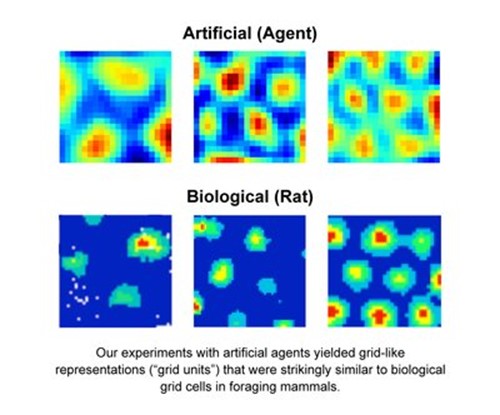
Navigation in AI-Brain and Bio-Brain
Most animals, including humans, are able to flexible navigate the complex world. They can explore new areas, returning quickly to remembered places, and taking shortcuts. The recent discovery in neuroscience, including place cells, grid cells, head direction cells, border cells, goal-vectorial cells, etc. are revealing the secrets of navigation in our brain.
In most recent paper from the DeepMind published in Nature, the authors developed an artificial agent to test the theory that grid cells support vector-based navigation, in keeping with their overarching philosophy that algorithms used for AI can meaningfully approximate elements of the brain.

The fig. is from Andrea et al., 2018

The fig. is from Andrea et al., 2018
In addition, the emergence of grid-like representations by training recurrent neural networks to perform spatial localization by Cueva and Wei, which was published contemporaneously at ICLR. While different in scope and findings, it shows interesting results. In brief, the authors found periodic firing that conformed to the shape of the enclosure, e.g rectangular grids in a square environment and triangular in a triangular environment (fig. 2 of Cueva and Wei). This differs from the study by Banino et al. , where they found grid-like units whose firing pattern closely resembles rodent grid cells which typically show hexagonal firing patterns across different shaped environments (e.g. square and circular arena).
For further info, please read the following references.
Andrea Banino, Caswell Barry, Benigno Uria, Charles Blundell, Timothy Lillicrap, Piotr Mirowski, Alexander Pritzel, Martin J. Chadwick, Thomas Degris, Joseph Modayil, Greg Wayne, Hubert Soyer, Fabio Viola, Brian Zhang, Ross Goroshin, Neil Rabinowitz, Razvan Pascanu, Charlie Beattie, Stig Petersen, Amir Sadik, Stephen Gaffney, Helen King, Koray Kavukcuoglu, Demis Hassabis, Raia Hadsell & Dharshan Kumaran. Vector-based navigation using grid-like representations in artificial agents. Nature (2018), doi:10.1038/s41586-018-0102-6. https://www.nature.com/articles/s41586-018-0102-6
Christopher J. Cueva, Xue-Xin Wei. Emergence of grid-like representations by training recurrent neural networks to perform spatial localization. ICLR 2018. https://openreview.net/forum?id=B17JTOe0-
The Nobel Prize in Physiology or Medicine 2014 was divided, one half awarded to John O’Keefe, the other half jointly to May-Britt Moser and Edvard I. Moser “for their discoveries of cells that constitute a positioning system in the brain“. https://www.nobelprize.org/nobel_prizes/medicine/laureates/2014/
Andrea Banino, Dharshan Kumaran, Caswell Barry. Navigating with grid-like representations in artificial agents. https://deepmind.com/blog/grid-cells/
Francesco Savelli & James J. Knierim. AI mimics brain codes for navigation. https://www.nature.com/articles/d41586-018-04992-7. doi: 10.1038/d41586-018-04992-7.
Alison Abbott. AI recreates activity patterns that brain cells use in navigation. https://www.nature.com/articles/d41586-018-05133-w
Will Knight. AI program gets really good at navigation by developing a brain-like GPS system. https://www.technologyreview.com/s/611105/robots-may-someday-explore-the-world-using-features-borrowed-from-your-brain/
John Rennie. Artificial Neural Nets Grow Brainlike Cells to Find Their Way. https://www.wired.com/story/artificial-neural-nets-grow-brainlike-cells-to-find-their-way/
About
CogNav Blog
New discovery worth spreading on cognitive navigation in neurorobotics and neuroscience
Recent Posts
- How to build a bio-inspired hardware implementation of an analog spike-based hippocampus memory model?
- How does the brain select what to remember during sleep?
- How hippocampal activity encodes numerous memories of specific events in life?
- How egocentric coding properties arise from its presynaptic inputs, and how egocentric cells represent items across different behavioral contexts?
- How the medial entorhinal cortex develops during learning and influences memory?
Tags
Categories
- 3D Movement
- 3D Navigation
- 3D Path Integration
- 3D Perception
- 3D SLAM
- 3D Spatial Representation
- AI Navigation
- Bio-Inspired Robotics
- Brain-Inspired Navigation
- Cognitive Map
- Cognitive Navigation
- Episodic Memory
- Excerpt Notes
- Flying Vehicle Navigation
- Goal Representation
- Insect Navigation
- Learning to Navigate
- Neural Basis of Navigation
- Path Integration
- Path Planning
- Project
- Research Tips
- Robotic Vision
- Self-Flying Vehicles
- Spatial Cognition
- Spatial Cognitive Computing
- Spatial Coordinate System
- Spatial Memory
- Time
- Unclassified
- Visual Cortex
- Visual Cue Cells
Links
- Laboratory of Nachum Ulanovsky
- Jeffery Lab
- BatLab
- The NeuroBat Lab
- Taube Lab
- Laurens Group
- Romani Lab
- Moser Group
- O’Keefe Group
- DoellerLab
- MilfordRobotics Group
- The Space and Memory group
- Angelaki Lab
- Spatial Cognition Lab
- McNaughton Lab
- Conradt Group
- The Fiete Lab
- The Cacucci Lab
- The Burak Lab
- Knierim Lab
- Clark Spatial Navigation & Memory Lab
- Computational Memory Lab
- The Dombeck Lab
- Zugaro Lab
- Insect Robotics Group
- The Nagel Lab
- Basu Lab
- Spatial Perception and Memory lab
- The Neuroecology lab
- The Nagel Lab
- Neural Modeling and Interface Lab
- Memory and Navigation Circuits Group
- Neural Circuits and Memory Lab
- The lab of Arseny Finkelstein
- The Epstein Lab
- Gu Lab (Spatial Navigation and Memory)
- Fisher Lab (Neural Circuits for Navigation)
- The Alexander Lab (Spatial Cognition and Memory)
- Harvey Lab (Neural Circuits for Navigation)
- Buzsáki Lab
- ……
